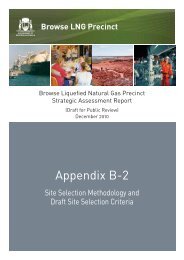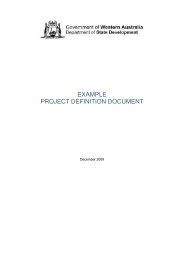Browse LNG Precinct - Public Information Booklet - Department of ...
Browse LNG Precinct - Public Information Booklet - Department of ...
Browse LNG Precinct - Public Information Booklet - Department of ...
You also want an ePaper? Increase the reach of your titles
YUMPU automatically turns print PDFs into web optimized ePapers that Google loves.
<strong>Public</strong> <strong>Information</strong> <strong>Booklet</strong><br />
The environmental issue is:<br />
� Significant additional soil disposal would be required, as the current design requires<br />
piling foundations, or removal, treatment and replacement <strong>of</strong> the soil (i.e. the soil is<br />
re-used, not dumped separately).<br />
Sinking <strong>of</strong> the <strong>LNG</strong> tanks to the ro<strong>of</strong> would incur significant additional cost. Initial<br />
enquiries to CB&I (an <strong>LNG</strong> tank building company) have indicated an additional cost <strong>of</strong><br />
about $500 million. This is due to the fact that this would place the <strong>LNG</strong> tank down into<br />
the harder sandstone material (harder to excavate) and below the water table.<br />
Partially sinking the <strong>LNG</strong> tank, for example, to the depth <strong>of</strong> the pindan sand, can be<br />
considered. As the soil could be backfilled, safety issues can be reduced. However, as<br />
the depth <strong>of</strong> the pindan soil is unclear until the site is agreed and surveys completed, the<br />
depth to which the tanks can be sunk is also unclear. Expectations are that the<br />
sandstone would be 10 to 15 metres (33 to 49 feet) below the pindan surface, but some<br />
improvement would be lost due to the tank foundations which were already below ground<br />
level. However as the total tank height is in the order <strong>of</strong> 45 metres (approximately 148<br />
feet), sinking the tanks by 10 to 15 metres (33 to 49 feet) would not provide much benefit.<br />
Question - Can you change the colour <strong>of</strong> the <strong>LNG</strong> plant equipment to green for<br />
example, instead <strong>of</strong> silver?<br />
As part <strong>of</strong> the Strategic Assessment, a visual impact assessment will be undertaken to<br />
increase the understanding <strong>of</strong> the visual impact <strong>of</strong> the facility/what it will look like on<br />
country from the land and the sea. The level <strong>of</strong> visual impact <strong>of</strong> a facility will depend on<br />
several things. Basically this involves understanding what country is like now such as the<br />
character <strong>of</strong> the selected site; the colour and type <strong>of</strong> terrain or hills in the area; the size<br />
and colour <strong>of</strong> existing plants in the area; the scale <strong>of</strong> the natural environment; the size<br />
and colour <strong>of</strong> the facility; the location <strong>of</strong> the facility; etc.<br />
Woodside as a potential foundation proponent will undertake a visual impact assessment<br />
to determine the level <strong>of</strong> visual impact <strong>of</strong> its proposed facility and to identify what could be<br />
changed so it doesnít look as obvious. Traditional Owners will be consulted in this study.<br />
Painting the plant a different colour (rather than the normal silver <strong>of</strong> the plant) will be part<br />
<strong>of</strong> the alternatives considered as it is technically feasible to paint significant portions <strong>of</strong><br />
the plant to help blend it in to country although it will have maintenance and cost<br />
implications.<br />
5279225 51









